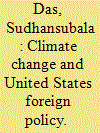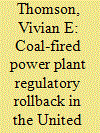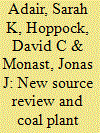| Srl | Item |
| 1 |
ID:
127528


|
|
|
| 2 |
ID:
162330


|
|
|
|
|
| Summary/Abstract |
President Trump wants to promote coal and weaken Clean Air Act regulations that affect coal-fired power plants. We analyze which US regions have benefited from air quality improvements realized since adoption of two Clean Air Act power plant rules, the transport and mercury rules, which have been targeted by lobbyists and national officials. For 20 coal states, we create a pre-regulatory emissions scenario for the current (2016) fleet of power plants. Using the US Environmental Protection Agency's CO-Benefits Risk Assessment screening model, we estimate the differences between the impacts of pre-regulatory emissions and current emissions on fine particulate matter (PM2.5) concentrations and on public health. We compare those impacts with voting patterns in the 2016 presidential election and with demographic data. Among the air quality and public health gains of the current situation relative to the pre-regulatory scenario are that: annual average PM2.5 concentrations are lower by 1–5 μg/m3; 17,176–39,291 premature mortalities are avoided for each year of lower emissions; coal mining counties and White, rural counties experience some of the best improvements in air quality; and, in several states, Trump counties benefit more than Clinton counties. We suggest refining these results with atmospheric dispersion models.
|
|
|
|
|
|
|
|
|
|
|
|
|
|
|
|
| 3 |
ID:
127179


|
|
|
| 4 |
ID:
121037


|
|
|
|
|
| Publication |
2013.
|
| Summary/Abstract |
Economic approaches are expected to achieve environmental goals at less cost than traditional regulations, but they have yet to find widespread application. One reason is the way these tools interact with existing institutions. The federalist nature of governmental authority assigns to subnational governments much of the implementation of environmental policy and primary authority for planning the infrastructure that affects environmental outcomes. The federalist structure also interacts with the choice of economic instruments; a national emissions cap erodes the additionality of actions by subnational governments. Even the flagship application of sulfur dioxide emissions trading has been outperformed by the venerable Clean Air Act, and greenhouse gas emissions in the United States are on course to be less than they would have been if Congress had frozen emissions with a cap in 2009. The widespread application of economic tools requires a stronger political theory of how they interact with governing institutions.
|
|
|
|
|
|
|
|
|
|
|
|
|
|
|
|
| 5 |
ID:
132769


|
|
|
|
|
| Publication |
2014.
|
| Summary/Abstract |
Forthcoming carbon dioxide (CO2) regulations for existing power plants in the United States have heightened interest in thermal efficiency gains for coal-fired power plants. Plant modifications to improve thermal efficiency can trigger New Source Review (NSR), a Clean Air Act requirement to adopt of state-of-the-art pollution controls. This article explores whether existing coal plants would likely face additional pollution control requirements if they undertake modifications that trigger NSR. Despite emissions controls that are or will be installed under the Mercury and Air Toxics Standards (MATS) and Clean Air Interstate Rule (CAIR) or its replacement, 80% of coal units (76% of capacity) that are expected to remain in operation are not projected to meet the minimum NSR requirements for at least one pollutant: nitrogen oxides or sulfur dioxide. This is an important consideration for the U.S. Environmental Protection Agency and state policymakers as they determine the extent to which CO2 regulation will rely on unit-by-unit thermal efficiency gains versus potential flexible compliance strategies such as averaging, trading, energy efficiency, and renewable energy. NSR would likely delay and add cost to thermal efficiency projects at a majority of coal units, including projects undertaken to comply with forthcoming CO2 regulation.
|
|
|
|
|
|
|
|
|
|
|
|
|
|
|
|
| 6 |
ID:
094838


|
|
|
|
|
| Publication |
2010.
|
| Summary/Abstract |
Data Envelopment Analysis (DEA) has been widely used for performance evaluation of many organizations in private and public sectors. This study proposes a new DEA approach to evaluate the operational, environmental and both-unified performance of coal-fired power plants that are currently operating under the US Clean Air Act (CAA). The economic activities of power plants examined by this study are characterized by four inputs, a desirable (good) output and three undesirable (bad) outputs. This study uses Range-Adjusted Measure (RAM) because it can easily incorporate both desirable and undesirable outputs in the unified analytical structure. The output unification proposed in this study has been never investigated in the previous DEA studies even though such a unified measure is essential in guiding policy makers and corporate leaders. Using the proposed DEA approach, this study finds three important policy implications. First, the CAA has been increasingly effective on their environmental protection.
|
|
|
|
|
|
|
|
|
|
|
|
|
|
|
|